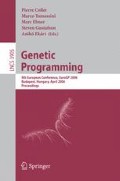Abstract
A common method for improving a genetic programming search on difficult problems is either multiplying the number of runs or increasing the population size.
In this paper we propose a new search strategy which attempts to obtain a higher probability of success with smaller amounts of computational resources. We call this model Divide & Conquer since our algorithm initially partitions the search space in smaller regions that are explored independently of each other. Then, our algorithm collects the most competitive individuals found in each partition and exploits them in order to get a solution. We benchmarked our proposal on three problem domains widely used in the literature. Our results show a significant improvement of the likelihood of success while requiring less computational resources than the standard algorithm.
Access this chapter
Tax calculation will be finalised at checkout
Purchases are for personal use only
Preview
Unable to display preview. Download preview PDF.
References
Banzhaf, W., Nordin, P., Keller, R.E., Francone, F.D.: Genetic Programming - An Introduction. In: On the Automatic Evolution of Computer Programs and its Applications, dpunkt.verlag, Morgan Kaufmann, San Francisco (1998)
Cantu-Paz, E., Goldberg, D.E.: Are Multiple Runs of Genetic Algorithms Better than One? In: Cantú-Paz, E., Foster, J.A., Deb, K., Davis, L., Roy, R., O’Reilly, U.-M., Beyer, H.-G., Kendall, G., Wilson, S.W., Harman, M., Wegener, J., Dasgupta, D., Potter, M.A., Schultz, A., Dowsland, K.A., Jonoska, N., Miller, J., Standish, R.K. (eds.) GECCO 2003. LNCS, vol. 2723, pp. 801–812. Springer, Heidelberg (2003)
Daida, J.M., Samples, M.E., Byom, M.J.: Probing for Limits to Building Block Mixing with a Tunably-Difficult Problem for Genetic Programming. In: Proceedings of the Genetic and Evolutionary Computation Conference GECCO 2005, June 25-29 (2005)
Daida, J.M.: Towards Identifying Populations that Increase the Likelihood of Success in Genetic Programming. In: Proceedings of the Genetic and Evolutionary Computation Conference GECCO 2005, June 25-29 (2005)
Gathercole, C., Ross, P.: Small Populations Over Many Generations Can Beat Large Populations Over Few Generations in GP. In: Koza, J.R., et al. (eds.) GP, pp. 111–118. Morgan Kaufmann, San Francisco (1997)
Koza, J.R.: Genetic Programming: On the Programming of Computers by Means of Natural Selection. MIT Press, Cambridge (1992)
Langdon, W.B., Poli, R.: Why Ants are Hard. In: Genetic Programming 1998. Proceedings of the Third Annual Conference (1998), pp. 193–201. Morgan Kaufmann publishers, San Francisco (1998)
Luke, S.: When Short Runs Beat Long Runs. In: Proceedings of the Genetic and Evolutionary Computation Conference GECCO 2001, pp. 74–80. Morgan Kaufmann publishers, San Francisco (2001)
Luke, S., Balan, G.C., Panait, L.: Population Implosion in Genetic Programming. In: Cantú-Paz, E., Foster, J.A., Deb, K., Davis, L., Roy, R., O’Reilly, U.-M., Beyer, H.-G., Kendall, G., Wilson, S.W., Harman, M., Wegener, J., Dasgupta, D., Potter, M.A., Schultz, A., Dowsland, K.A., Jonoska, N., Miller, J., Standish, R.K. (eds.) GECCO 2003. LNCS, vol. 2724, pp. 1729–1739. Springer, Heidelberg (2003)
Alba, E., Tomassini, M.: Parallelism and Evolutionary Algorithms. IEEE Transactions on Evolutionary Computation 6(5), 443–462 (2002)
Van Veldhuizen, D.A., Zydallis, J.B., Lamont, G.B.: Considerations in Engineering Parallel Multiobjective Evolutionary Algorithms. IEEE Transactions on Evolutionary Computation 7(2), 144–173 (2003)
Author information
Authors and Affiliations
Editor information
Editors and Affiliations
Rights and permissions
Copyright information
© 2006 Springer-Verlag Berlin Heidelberg
About this paper
Cite this paper
Fillon, C., Bartoli, A. (2006). A Divide & Conquer Strategy for Improving Efficiency and Probability of Success in Genetic Programming. In: Collet, P., Tomassini, M., Ebner, M., Gustafson, S., Ekárt, A. (eds) Genetic Programming. EuroGP 2006. Lecture Notes in Computer Science, vol 3905. Springer, Berlin, Heidelberg. https://doi.org/10.1007/11729976_2
Download citation
DOI: https://doi.org/10.1007/11729976_2
Publisher Name: Springer, Berlin, Heidelberg
Print ISBN: 978-3-540-33143-8
Online ISBN: 978-3-540-33144-5
eBook Packages: Computer ScienceComputer Science (R0)

